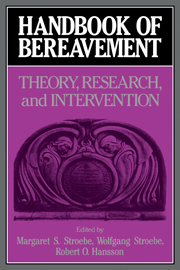Book contents
- Frontmatter
- Contents
- Contributors
- Preface
- Part I Introduction
- Part II The phenomenology and measurement of grief
- Part III Current theories of grief, mourning, and bereavement
- Part IV Physiological changes following bereavement
- Part V The psychological, social, and health impacts of conjugal bereavement
- 12 The mortality of bereavement: A review
- 13 Psychological resilience among widowed men and women: A 10-year follow-up of a national sample
- 14 Determinants of adjustment to bereavement in younger widows and widowers
- 15 The impact of spousal bereavement on older widows and widowers
- 16 The course of spousal bereavement in later life
- 17 Risk factors in bereavement outcome
- Part VI Grief reactions to different types of loss
- Part VII Coping, counseling, and therapy
- Part VIII Conclusions
- References
- Author index
- Subject Index
15 - The impact of spousal bereavement on older widows and widowers
Published online by Cambridge University Press: 04 May 2010
- Frontmatter
- Contents
- Contributors
- Preface
- Part I Introduction
- Part II The phenomenology and measurement of grief
- Part III Current theories of grief, mourning, and bereavement
- Part IV Physiological changes following bereavement
- Part V The psychological, social, and health impacts of conjugal bereavement
- 12 The mortality of bereavement: A review
- 13 Psychological resilience among widowed men and women: A 10-year follow-up of a national sample
- 14 Determinants of adjustment to bereavement in younger widows and widowers
- 15 The impact of spousal bereavement on older widows and widowers
- 16 The course of spousal bereavement in later life
- 17 Risk factors in bereavement outcome
- Part VI Grief reactions to different types of loss
- Part VII Coping, counseling, and therapy
- Part VIII Conclusions
- References
- Author index
- Subject Index
Summary
The purpose of this chapter is twofold: to summarize basic results from two longitudinal studies of how elders adapt to death of their spouse, depending on whether the death was due to natural causes or to suicide; and to review what these studies have found regarding the possible correlates of good versus poor outcome. A final objective is to present some thoughts about unanswered questions and to suggest further research to shed light on these issues.
The University of Southern California (USC) spousal bereavement study
Although spousal loss occurs predominantly late in life (U.S. Bureau of Census, 1988), few studies have systematically assessed the response to this loss in older adults. The primary objective of the USC study was to assess longitudinally the impact of spousal loss on the mental and physical health of older widows and widowers. In addition, we also evaluated specific predictors of bereavement outcome in light of existing theory and previous research (e.g., Freud, 1917b; Parkes & Brown, 1972). Of particular interest in the USC study were the following factors, each of which alone, and in combination, was thought to be causally related to bereavement outcome: personality and ego strength, social support, religiosity, marital quality, anticipation of loss, and cumulative losses/stressors.
Sample characteristics and research design
Two samples of older adults were compared in the USC study. One sample comprised 212 recently widowed elders (99 males and 113 females) who had lost their spouse as a result of natural causes.
- Type
- Chapter
- Information
- Handbook of BereavementTheory, Research, and Intervention, pp. 227 - 239Publisher: Cambridge University PressPrint publication year: 1993
- 43
- Cited by

